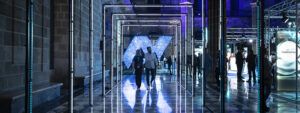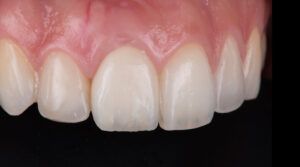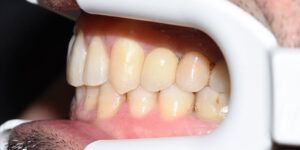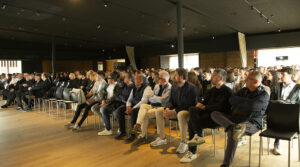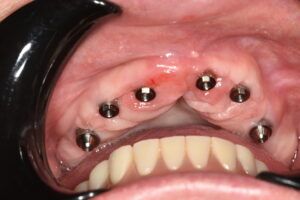La demanda estética actual que muchos pacientes presentan, ha hecho que los criterios de éxito en implantes dentales en el sector anterior se actualicen e impliquen ya no sólo la osteointegración del implante, sino la estabilidad periimplantaria del tejido duro y del tejido blando a largo plazo.
Esta estabilidad periimplantaria puede verse comprometida cuando ya existe una pérdida de tejidos consecuencia de la propia remodelación inevitable que sufre cualquier alvéolo después de la exodoncia de un diente. Es por esta razón que cuando estamos tratando el sector anterior tenemos que ver opciones terapéuticas que nos permitan reducir o compensar el remodelado inevitable que va a tener ese alvéolo después de la exodoncia del diente mediante la regeneración alveolar o mediante la implantología inmediata.
Nuestro compromiso con el paciente es poder compensar ese tejido duro y blando que se va a perder para que la colocación tridimensional del implante sea la correcta, la higienización y estética de la corona sobre implante sea óptima y la predictibilidad de nuestro tratamiento no se vea comprometida a largo plazo 1.
El papel que juega hoy día la implantología inmediata y la carga inmediata en el sector anterior 2, 3 es de capital importancia para poder entender que todo proceso quirúrgico de colocación de un implante inmediato conlleva un correcto manejo del alvéolo, de la mucosa y del diseño de la prótesis provisional de transición hasta llegar a la corona definitiva 4, 5,6.
Estamos pues ante el llamado equilibrio cirugía-periodoncia-prótesis, donde las tres especialidades serán las encargadas de ofrecernos un resultado predecible a largo plazo cuando tratamos el sector estético anterior.
Presentamos a continuación un caso clínico de fractura coronal del 11 con lesión periapical, donde indicamos la exodoncia del diente. Es aquí donde se tuvieron en cuenta varias posibilidades de tratamiento.
Posibilidad 1: Exodoncia del diente con regeneración alveolar y colocación del implante diferido
Posibilidad 2: Exodoncia del diente y colocación del implante inmediato
Después de la exploración clínica, radiográfica y tomográfica se decidió proceder con la exodoncia del 11, implante inmediato y carga inmediata estética para poder controlar y compensar el remodelado óseo y de tejido blando que iba a tener la zona después de la exodoncia 1.


Se realizó exodoncia de la pieza 11 y colocación de un implante Biomimetic Ocean (Avinent Implant System), de 3,5x13mm, guiado protésicamente por férula quirúrgica confeccionada con resina que nos ofrecía la posición tridimensional correcta del diente a restaurar y que nos serviría a su vez como corona provisional de carga inmediata.

El torque de inserción fue de 45Ncm, se retiró el transportador del implante y se talló el mismo para poder rebasar sobre él la corona provisional de la propia férula quirúrgica. Siguiendo las pautas de contorno crítico y subcrítico establecidas por Óscar González7, se colocó la corona provisional atornillada y se rebasó al transportador del implante, previamente pintado con opáquer para poder dejar la corona provisional un total de 4 meses y así manejar adecuadamente el contorno de la mucosa. A partir del tercer mes de carga se empezó a modificar el perfil de emergencia para conseguir el estado actual de la mucosa.

A los 4 meses se tomó una impresión individualizada mediante un transfer de cubeta cerrada customizado con flow, según el perfil de emergencia conseguido con el provisional 8, 9, y se confeccionó mediante CAD-CAM una corona definitiva metal cerámica atornillada al implante (Core3dcentres).




BIBLIOGRAFÍA
-
- Araújo MG, Sukekava F, Wennström JL, Lindhe J. Riedge alterations following implant placement in fresh extraction sockets: an experimental study in the dog. Clin Periodontol 2005;32:645-652
-
- Kan JY, Rungcharassaeng K, Lozada J. Immediate placement and provisionalization of maxillary anterior single implants: 1-year prospective study. Int J Oral Maxillofac Implants., 203;18:31-39
-
- Chen ST, Wilson TG Jr, Hämmerle CH. Immediate or early placement of implants following tooth extraction: review of biologic basis, cliical procedures, and outcomes. Int J Oral Maxillofac Implants 2004;19(suppl):12-25
-
- Hämmerle CH, Chen ST, Wilson TG Jr. Consensus statements and recommended clinical procedures regarding the placement of implants in extraction sockets. Int J Oral Maxillofac Implans 2004;19(suppl):26-28
-
- Cornellini R, Cangini F, Covani U, Wilson TG Jr. Immediate restoration of implants placed into fresh extraction sockets for single-tooth replacement: a prospective clinical study. Int J Periodontics Restorative Dent 2005;25;439-447
-
- Esposito M, Grusovin MG, Willings M, Coulthard P, Worthington HV. Interventions for replacing missing teeth:different times for loading dental implants. Cochrane Database Syst Rev 2007;18:CD003878
-
- Su H1, Gonzalez-Martin O, Weisgold A, Lee E . Considerations of implant abutment and crown contour: critical contour and subcritical contour. Int J Periodontics Restorative Dent. 2010 Aug;30(4):335-43.
-
- Hinds KD. Custom impression coping for an exact registration of the healed tissue in the esthetic implant restoration. Int J Periodontics Restorative Dent. 1997 Dec;17(6):584-91.
-
- Papadopoulos I1, Pozidi G, Goussias H, Kourtis S. Transferring the emergence profile from the provisional to the final restoration. J Esthet Restor Dent. 2014 May-Jun;26(3):154-61. doi: 10.1111/jerd.12068. Epub 2013 Dec 17.





